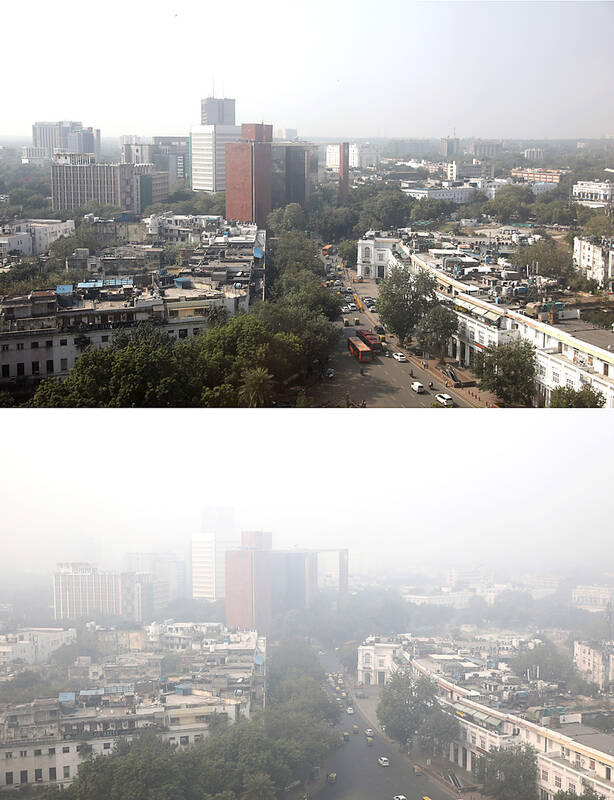Millions of Indians celebrated Diwali on Sunday with a Guinness World Record number of bright earthen oil lamps as concerns about air pollution soared in the South Asian country.
Across the nation, dazzling multicolored lights decked homes and streets, as devotees celebrated the annual Hindu festival of light symbolizing the victory of light over darkness.
However, the spectacular and much-awaited massive lighting of the oil lamps took place — as usual —at Saryu River, in Ayodhya in Uttar Pradesh state, the birthplace of their most revered deity, the god Ram.

Photo: EPA-EFE
At dusk on Saturday, devotees lit more than 2.22 million lamps and kept them burning for 45 minutes as Hindu religious hymns filled the air at the banks of the river, setting a new world record. Last year, more than 1.5 million earthen lamps were lit.
After counting the lamps, Guinness Book of World Records representatives presented a record certificate to the state’s top elected official, Yogi Adityanath.
More than 24,000 volunteers, mostly college students, helped prepare for the new record, said Pratibha Goyal, vice chancellor of Dr. Ram Manohar Lohia Avadh University in Ayodhya.
Diwali, a national holiday across India, is celebrated by socializing and exchanging gifts with family and friends. Many light earthen oil lamps or candles, and fireworks are set off as part of the celebrations. In the evening, a special prayer is dedicated to the Hindu goddess Lakshmi, who is believed to bring luck and prosperity.
Over the weekend, authorities ran extra trains to accommodate the huge numbers trying to reach their hometowns to join family celebrations.
The festival came as worries about air quality in India rose. A “hazardous” 400 to 500 level was recorded on the air quality index last week, more than 10 times the global safety threshold, which can cause acute and chronic bronchitis and asthma attacks. However, on Saturday, unexpected rain and a strong wind improved the levels to 220, according to the government-run Central Pollution Control Board.
Air pollution level is expected to soar again after the celebrations end on Sunday night because of the fireworks used.
Last week, officials in New Delhi shut down primary schools and banned polluting vehicles and construction work in an attempt to reduce the worst haze and smog of the season, which has posed respiratory problems for people and enveloped monuments and high-rise buildings in and around India’s capital.

‘GREAT OPPRTUNITY’: The Paraguayan president made the remarks following Donald Trump’s tapping of several figures with deep Latin America expertise for his Cabinet Paraguay President Santiago Pena called US president-elect Donald Trump’s incoming foreign policy team a “dream come true” as his nation stands to become more relevant in the next US administration. “It’s a great opportunity for us to advance very, very fast in the bilateral agenda on trade, security, rule of law and make Paraguay a much closer ally” to the US, Pena said in an interview in Washington ahead of Trump’s inauguration today. “One of the biggest challenges for Paraguay was that image of an island surrounded by land, a country that was isolated and not many people know about it,”

DIALOGUE: US president-elect Donald Trump on his Truth Social platform confirmed that he had spoken with Xi, saying ‘the call was a very good one’ for the US and China US president-elect Donald Trump and Chinese President Xi Jinping (習近平) discussed Taiwan, trade, fentanyl and TikTok in a phone call on Friday, just days before Trump heads back to the White House with vows to impose tariffs and other measures on the US’ biggest rival. Despite that, Xi congratulated Trump on his second term and pushed for improved ties, the Chinese Ministry of Foreign Affairs said. The call came the same day that the US Supreme Court backed a law banning TikTok unless it is sold by its China-based parent company. “We both attach great importance to interaction, hope for

‘FIGHT TO THE END’: Attacking a court is ‘unprecedented’ in South Korea and those involved would likely face jail time, a South Korean political pundit said Supporters of impeached South Korean President Yoon Suk-yeol yesterday stormed a Seoul court after a judge extended the impeached leader’s detention over his ill-fated attempt to impose martial law. Tens of thousands of people had gathered outside the Seoul Western District Court on Saturday in a show of support for Yoon, who became South Korea’s first sitting head of state to be arrested in a dawn raid last week. After the court extended his detention on Saturday, the president’s supporters smashed windows and doors as they rushed inside the building. Hundreds of police officers charged into the court, arresting dozens and denouncing an

RELEASE: The move follows Washington’s removal of Havana from its list of terrorism sponsors. Most of the inmates were arrested for taking part in anti-government protests Cuba has freed 127 prisoners, including opposition leader Jose Daniel Ferrer, in a landmark deal with departing US President Joe Biden that has led to emotional reunions across the communist island. Ferrer, 54, is the most high-profile of the prisoners that Cuba began freeing on Wednesday after Biden agreed to remove the country from Washington’s list of terrorism sponsors — part of an eleventh-hour bid to cement his legacy before handing power on Monday to US president-elect Donald Trump. “Thank God we have him home,” Nelva Ortega said of her husband, Ferrer, who has been in and out of prison for the